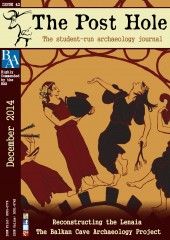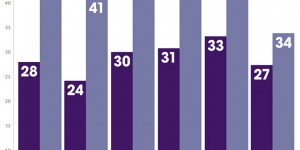The best-known of the Athenian dramatic festivals is the City Dionysia; a huge civic festival which took place in the Greek month of Elaphebolion, which equates to our late March (Csapo and Williams 1998, 105) and attracted audiences from all over Greece. However, Greek drama was not confined to the City Dionysia (or even to Athens). A number of smaller festivals included dramatic performances, many of which took place on a smaller scale amid rural Attic demes (Haigh 1907, 29) . Meanwhile, the polis-wide Lenaia was celebrated in the Athenian month of Gamelion, which is approximate to our January. Details on the festival are scant, but with careful investigation we can begin to build up a bigger picture.
Two poets presented a pair of tragedies at the Lenaia (compared to three poets with trilogies at the City Dionysia), but later the number of pairs was increased to three (Csapo and Slater 1998, 136f, III.74-III.75). There is no evidence to suggest that any satyr plays were performed. During Aristophanes’ career, three comedies were performed (Pickard-Cambridge 1973, 25), but a list of Lenaian comedies performed in 285/4 indicates that there were five (Csapo and Slater 1998, 137, III.77). Csapo and Slater (1998, 124) reiterate “the usual handbook dogma that five comedies were regularly produced at the Lenaea except during the Peloponnesian War” but equally, we might hypothesise that the number started out as three regardless of the war, and was later increased to five. Dithyrambs were also added in the third century (Csapo and Slater 1998). At any rate, this would suggest a festival of three or five days, with one comedy being performed per day, as well as two (and later three) days which included tragic performances; it is possible that the tragedies filled the timeslot allocated to the procession on the first day. If the festival was indeed expanded, this suggests it must have been popular. Comic plays took precedence at the Lenaia, as compared to the City Dionysia where tragedy reigned (Csapo and Slater 1998, 43, I.102). But the Lenaia was probably considered the lesser dramatic arena for both genres; so that when Plato Comicus did poorly at the City Dionysia, his comedies were apparently relegated to the Lenaia once more (Csapo and Slater 1998, 135, III.71). There was probably less money to spend on performances at the festival. Unlike at the City Dionysia, metics were allowed as choregoi and foreigners could be chorus-members (Csapo and Slater 1998, 135, III.72).
Pickard-Cambridge (1973, 29) notes that the Lenaia might derive its name “from a connexion with the winepress, ληνός” but dismisses the theory because “the special reference to the winepress and its god in January or February was not obviously appropriate”. An alternative explanation is that the name stems from “λῆναι, known to be an appellation of bacchanals or maenads” (Pickard-Cambridge 1973, 29). Equally possible linguistically, this interpretation perhaps is made more likely because it is unaffected by the festival’s date. Of course, it is entirely possible that an early form of the Lenaia took place at a different time of year and was then moved – Greek festivals “were in a state of perpetual temporal movement” (Slater 2011, 30) – but even if it was a festival originally associated with wine production, its date change would indicate a move away from that focus to become a more general Dionysian festival. At any rate, the explanation of a festival to Dionysus as god of bacchants prevents no such difficulties, and therefore must hold the benefit of doubt.
There was also a procession, overseen by the archōn basileus along with the dramatic performances (Csapo and Slater 1998, 132, III.61). The procession seems to have involved “revellers on the wagons [who] mock and insult everyone they meet” (Csapo and Slater 1998, 132, III.62B) but accounts of this aspect are late, and tend to generalise about all Dionysian festivals. There is no reason to doubt that the practice took place, but there is a small possibility that it has been wrongly assigned to the Lenaia (unless it took place at various festivals). Regardless, such a procession would fit our understanding of the Greek practice of aischrology, the use of insult within the practices of some religious rites, as a form of worship through laughter.
It is not fully certain when comic competition started at the Lenaia, but it seems to have been at some point in the 430s (Csapo and Slater 1998, 133f, III.68). Comic performances may well have pre-dated this however – indeed, Haigh (1907, 27) argues that they started “as early as 487”. But if comedy had long been associated with the festival, it is hard to see why nobody would have thought to make the performances competitive (as with other dramatic festivals) until the 430s. Given their humorous nature, it seems far more likely that they were a later addition into a festival which had previously placed emphasis on gelastic and aischrological rituals such as the procession. Halliwell (2008, 206) has suggested that the performance of Old Comedy itself may also be “classed as a case of ‘ritual laughter’” because of its origins, content, and affiliation with Dionysus, and because “Old Comedy displays an inclination to incorporate echoes and adaptations of ritual laughter into its own performances”. Whilst his conclusion is ultimately cautious, such an interpretation would help to explain the irreverent tone of Old Comedy within the larger context of Greek ritual as something fundamentally tied up with the concept of religious practice, another facet of a gelastic tradition which used laughter as a form of worship. Within the specific context of the Lenaia, this might indicate why a festival which incorporated ritualistic laughter into its worship of Dionysus would later add comic performances. Old Comedy can therefore be seen as just one specific form of a general and varied framework of gelastic ritual, which fulfilled an important role in Dionysiac worship at the Lenaia, and Greek worship in general. Tragedy was shortly added too, as a natural counterbalance to the comic performances – a list of victors indicates that this was in place at least by 420 (Csapo and Slater 1998, 136, III.74). There were also prizes for the best tragic and comic lead actors.
Originally, the City Dionysia and the Lenaia were celebrated in two separate locations. Pickard-Cambridge (1973, 37f) tentatively suggests that the Lenaia was first situated in the market-place and, in absence of archaeology denoting a clear Lenaion district, this seems at least plausible. But when comic performances were introduced, they were surely performed in the Theatre of Dionysus on the Acropolis. Any theatre set up in the Lenaion would have amounted to simple wooden benches set up in front of an open performance space without a stage or skene; the same sort of inadequate venue the Theatre was built to surmount. Indeed, it is hard to believe that the Lenaia’s dramatic performances would be put on in a make-shift fashion when a perfectly suitable theatre already existed within the city. This theatre was still semi-temporary but nevertheless offered performances more options because of the skene and stage. Around 329, Lycurgus built a permanent stone theatre (Goette 2011, 116). Russo (1994, 3f) attempts to refute that the Lenaian plays were performed in the Theatre of Dionysus by arguing that plays at each festival use the theatre space in fundamentally different ways. But his conclusions rely on shaky evidence. There is nothing to prevent plays at the City Dionysia using the theatre’s side corridors as regular exits for instance, and they had probably been used as such since at least Aeschylus . The remaining rituals of the Lenaia did not presumably move with the dramatic performances. But we cannot be certain, given that the Theatre was indeed used for aspects of the City Dionysia’s non-dramatic rituals.
We may also be able to assign an additional ritual to the Lenaia, a ritual which, interestingly, seems to have been solely for women. The evidence for this is dependent on a series of vases indicating Dionysian worship; aptly named the Lenaian Vases. These vases are adorned with a myriad of different, if not dissimilar images variously portraying women dancing and making music, women drinking and pouring wine from a stamnos, women holding thyrsoi, and images of satyrs. There seems to be two distinct types: black-figure lekythoi from 490-80, which show women in an ecstatic state, and red-figure stamnoi from 460-50, focused on the pouring of wine; many of this type were found in Etruria (Hamilton 2003, 49). Other divisions have been made. However, the unifying feature of all of them (or at least those we can be sure fit into this group) is the inclusion of a pillar adorned with a mask of Dionysus, around which the portrayed ritual is focused. According to Hamilton (2003, 50), these idols and herms “are the only type of divine statues found in non-mythological scenes on Athenian vases” - a significant enough reason to group them together. It is also rare for women to appear in a group without men in Athenian pottery (Hamilton 2003, 53), and so we might consider this an additional unifying factor. The ritual depicted is one focused on women becoming maenads through the replication of traditional maenadic acts; dancing, singing, drinking wine. This would explain the presence of satyrs and thyrsoi in some of the vases; they are there to indicate the transformation process. The process would function as a means of worshipping Dionysus in his role as god of the maenads. Such a ritual would fit in with our knowledge of other Greek festivals, which involved transformative rites intended to convert the initiates into the characters of a mythic story (Dowden 2002, 102-104). The justification to assign this particular ritual to the Lenaia as opposed to another festival is that, in the absence of knowledge of a more appropriate festival, the Lenaia seems the most likely option given the probability of its name deriving from an alternative name for the maenads. Obviously, this is tentative, and it is surprising that no textual evidence for the practice survives, not least in our corpus of Lenaian comedy. But the balance of probability still favours the Lenaia. There is also no way to say for certain where the ritual took place, but there seems to be two possibilities; it was either performed at women’s houses in small groups as a semi-private ritual, or at the aforementioned Lenaion. The variations in portraying the masked column suggest that it was a temporary structure, implying the former setting. The participants seem to be of no specific age, so we are surely not dealing with a ritual designed for maidens; we cannot be certain if unmarried women were included, however.
We can say with certainty that the Lenaia was not a festival specifically designed to attract overseas visitors. This is because the sailing season did not start until the time of the Dionysia, so most foreigners from outside of Athens could not get to the city in order to attend. This is also made clear by a passage of Aristophanes;
“For we are by ourselves; it’s the Lenaean competition, and no foreigners are here yet; neither tribute nor troops have arrived from the allied Cities. This time we are by ourselves, clean-hulled – for I count the resident foreigners as the bran of our populace” (Henderson 1998, 504-8).
But as the passage also indicates, there was no restriction on non-citizen residents or metics attending the performances; we might therefore assume they were present at the procession too.
Disagreements about whether women attended the Athenian theatre have “run longer than The Mousetrap” (Hughs 2012, 207), but the balance of probability suggests a small number did. The fact that the plays never directly acknowledge or address a female segment of the audience certainly does not rule out their presence; in such a male-centric society, it is easy to believe that the poets rarely even thought about their female audience, especially if the number was slight. Plato clearly indicates that, by the fourth century, women were present at least at some dramatic performances, which may well lead us to suggest they probably attended all performances both by that time and throughout the fifth century as well (Bury 1926, II.658a-d; Lamb 1991, 502c-d). Now let us consider the following passage from Aristophanes’ Peace;
“Slave: Of all these spectators there isn’t one who hasn’t got some seed.
Trygaeus: The women haven’t had any.
Slave: Well, the men will give it to them tonight!”
(Sommerstein 1985, 964-7).
This could admittedly be used to argue that women were not present (and thus did not get any of the slave’s seed). But alternatively, it may merely suggest that women sat at the back of the theatre (so that the seed would not reach them). This segregation would also help to explain why poets do not address women amongst the rest of the audience. Or possibly the actor may have avoided throwing any seed at women sat throughout the theatre so that the sexual pun could be made. Again, Peace was produced at the City Dionysia, so it is conceivable that women were only barred from attending the largest festival (although it is unclear why some performances would be deemed suitable and not all). Ultimately, the issue must remain contentious, but we certainly must not rule out the strong possibility that they were in the audience for the Lenaian dramatic performances. At any rate, their numbers would have been small – after all, as Pomeroy notes, “women who did not have slaves to tend their babies were probably not able to attend a full day’s performance, or even to see one play” (1994, 80).
There is no specific evidence to confirm women’s involvement in the procession, but it certainly is not possible to say they could not have been there; they took a central role in other processions, including the Panathenaia (Pomeroy 1994, 75). Even though the ritual probably involved aischrological elements, it is wrong to suggest women would not have partaken in such rites because it was inappropriate, since the mythic origin of insult-rites stems from the interaction between two women (West 2003, 197-205). And in the Lenaia-performed Lysistrata, a scene portraying the public humiliation of citizens by the two half-choruses involves both men and women and in fact works to unify the two gender-split half-choruses into one (Sommerstein 2007, 1073-96) – this scene was conceivably intended to recall the aischrology at the heart of the festival’s procession. Of course, if we are to assume women were present at both the plays and religious drinking rituals, and that the Lenaia was at least originally a festival connected to the female worship of Dionysus, it seems impossible to deny that they must also have taken part in the procession.
Another contentious issue is the size of the audience who could fit into the pre-Lycurgan Theatre of Dionysus. A confusing passage of Plato cites an audience of 30,000 at a festival in 416 which seems to have been the Lenaia (Csapo and Slater 1998, 135, III.70A, III.70B). However, archaeology suggests this cannot have been the case; ignoring the fact that Plato even overshoots the capacity of the later construction, the first theatre must have been much smaller than that (Goette 2011, 120). Given this, an estimate in the range of 5,000 is more suitable. That capacity is still twice as large as that of the Sydney Opera House, but nowhere close to being able to seat every Athenian citizen, before children, women, slaves and metics are even considered. It is quite possible that many people only watched a single day’s performance, although given the contest element, it is conceivable that there was interest in attending every day. Tickets must have gone to those who firstly both had the time and money to spare, and secondly were first in line to buy them. At least until the construction of a stone theatre, tickets for the City Dionysia were two obols a day, paid to those who had constructed the semi-permanent Theatre of Dionysus for the festival (Wilson 2008, 92); given that the same construction would need to take place for the Lenaia, we can guess that the entrance fee was the same.
Many scholars are tempted to seek out distinctions between the comedies at each festival. McLeish states that “the two main festivals… were markedly different in style” (1980, 27); Russo argues for a great difference in the tone of the plays to correspond to what he sees as two very distinct “theatre seasons” (1994, 1). Simply put, this formula would indicate lavish, uncomplicated spectacle for the City Dionysia and witty, political and Athenocentric material for the Lenaia. Does this distinction stand up to scrutiny? Aristophanes was apparently attacked for denigrating Athens at the City Dionysia in front of the allies (Henderson 1998, 502f), and this perhaps suggests that the Lenaia was the preferred festival for harsh criticism of domestic politics. Despite being about the Peloponnesian War, Lysistrata, which surely must have been performed at the Lenaia , is not as Panhellenic as it may seem; for all its inclusion of quips at different nationalities (Sommerstein 2007, 78-92), actors only play Athenians and Spartans. Thus, the very Panhellenic war is essentially boiled down to a conflict between two big players. Whether this proves that the Lenaia specialised in Athenocentric comedy or not remains debatable, but we must at least conclude that Lysistrata makes no pains to extensively represent a multicultural cast, presumably because the audience was not as multicultural as it would have been at the City Dionysia. Conversely however, Clouds was performed at the City Dionysia and yet talks about the seemingly Athenian subject of Socrates. The Lenaian Wasps is not by any means a cheap performance, relying as it does on an elaborate set and costumes. So whilst the evidence seems to suggest a preference for a particular style at each festival, presumably dictated in large part by finances and audience, we would be wrong to suggest that poets were rigidly bound by two distinct and immutable styles.
The festival was almost certainly more complex than the basic picture we have drawn gives credit for, and may well have involved various other rituals and customs. But the ultimate picture we have been able to piece together, if tentative, suggests a winter festival to Dionysus as god of the maenads. The rituals seem to have highlighted Dionysus’ transgressive nature, with a procession involving aischrology and a female-only drinking rite involving wine and a symbolic transformation into maenads. Originally, the Lenaia was probably not a dramatic festival, with comedy added because of its natural affinity with aischrological rites and connection to Dionysus, and later tragedy and dithyramb because of their connection to comedy. The number of performances grew over time, suggesting the expansion of a popular festival. Whilst it is important not to overemphasise the point, there does seem to be some small differentiation between those comedies performed at the Lenaia and those at the City Dionysia. The Lenaian performances almost certainly took place in the Theatre of Dionysus on the Acropolis, but the Lenaion, the original home of the festival, no doubt continued to be used for the remaining rites (although not the drinking party, which seems to have been a semi-private ritual). The Lenaion may have been in the agora. Because of the season in which it was put on, the festival was a domestic affair, but metics and women probably took part in every aspect; women could attend the theatre. Tickets to performances were presumably at the same two-obol rate as at the City Dionysia, and a small capacity in the original theatre would have meant competition for tickets. It is a shame we cannot say any more with confidence; like so many aspects of the classical world, the truth may forever be veiled from us by sheer lack of evidence.
Footnotes
1.Although some demes were large and well-populated. The Rural Dionysia in Piraeus was popular, state-funded and distinguished enough to attract poets as great as Euripides.
2.In Persai, the queen first enters by a side corridor on a chariot, and so must surely leave on the chariot by the same exit (unless stage-hands remove the chariot) (Hall 2007, 607-9). In Sophocles’ Ajax, a scene ends with Tecmessa entering into the skene and Ajax leaving by a different exit that must have been an eisodos (Garvie 1998, 654-63; 684-6).
3.“It is very, very hard to credit [Aristophanes] with the suicidal recklessness that it would have taken to put on a play like Lys. at the City Dionysia of 411” (Sommerstein 1977, 120).
Bibliography
- Bury, R.G. (1926) Translated: Plato, Laws I. London: Loeb Classical Library.
- Csapo, E. and Slater, W.J. (1998) The Context of Ancient Drama, Ann Arbor, MI: The University of Michigan Press.
- Dowden, K. (2002) The Uses of Greek Mythology, Abingdon: Routledge.
- Garvie, A.F. (1998) Edited and Translated: Sophocles, Ajax. Oxford: Aris & Phillips.
- Goette, H.R. (2011) ‘An Archaeological Appendix’ in P. Wilson (ed) The Greek Theatre and Festivals Oxford: Oxford University Press.
- Haigh, A.E. (1907) in A. Pickard-Cambridge (ed) The Attic Theatre (3rd Edition) Oxford: Clarendon.
- Hall, E. (2007) Edited and Translated: Aeschylus, Persians. Oxford: Aris & Phillips.
- Halliwell, S. (2008) Greek Laughter, Cambridge: Cambridge University Press.
- Hamilton, R. (2003) ‘Lenaea Vases in Context’ in E. Csapo and M. Miller (eds) Poetry, Theory and Praxis, Oxford: Oxbow.
- Henderson, J. (1998) Edited and Translated: Aristophanes, ‘Acharnians’ in Aristophanes: Acharnians; Knights. London: Loeb Classical Library.
- Hughs, A. (2012) Performing Greek Comedy, Cambridge: Cambridge University Press.
- Lamb, W.R.M. (1991) Translated: Plato, ‘Gorgias’ in Plato: Lysis; Symposium; Gorgias. London: Loeb Classical Library.
- McLeish, K. (1980) The Theatre of Aristophanes, London: Thames and Hudson.
- Pickard-Cambridge, A. (1973) The Dramatic Festivals of Athens (2nd Edition), Oxford: Oxford University Press.
- Pomeroy, S.B. (1994) Godesses, Whores, Wives and Slaves, London: Pimlico.
- Russo, C.F. (1994) Aristophanes: An Author for the Stage (trans. K. Wren), London: Routledge.
- Slater, W.J. (2011) ‘Deconstructing Festivals’ in P. Wilson (ed) The Greek Theatre and Festivals Oxford: Oxford University Press.
- Sommerstein, A.H. (1977) ‘Aristophanes and the Events of 411’, The Journal of Hellenic Studies 97, 120.
- Sommerstein, A.H. (1985) Edited and Translated: Aristophanes, Peace. Warminster: Aris & Phillips.
- Sommerstein, A.H. (2007) Edited and Translated: Aristophanes, Lysistrata. Eastbourne: Aris & Phillips.
- West, M.L. (2003) Edited and Translated: [Homer], ‘Homeric Hymns: 2. To Demeter’ in Homeric Hymns; Homeric Apocrypha; Lives of Homer. London: Loeb Classical Library.
- Wilson, P. (2008) ‘Costing the Dionysia’ in M. Revermann and P. Wilson (eds) Performance, Iconography, Reception, Oxford: Oxford University Press.








